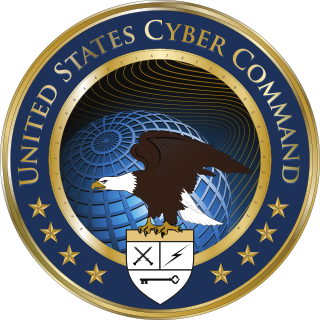 W
WUnited States Cyber Command (USCYBERCOM) is one of the eleven unified combatant commands of the United States Department of Defense (DoD). It unifies the direction of cyberspace operations, strengthens DoD cyberspace capabilities, and integrates and bolsters DoD's cyber expertise.
 W
WAir Force Cyber Command (Provisional) was a proposed United States Air Force Major Command that existed only in provisional status. On 6 October 2008, the Air Force announced that the command would not be brought into permanent activation, and that the cyber mission would be transferred, with the standup of the Twenty-Fourth Air Force, to Air Force Space Command.
 W
WU.S. Army Cyber Command (ARCYBER) conducts information dominance and cyberspace operations as the Army service component command of United States Cyber Command.
 W
WThe U.S. Marine Corps Forces Cyberspace Command is a functional formation of the United States Marine Corps to protect critical infrastructure from cyberattack. Marine Corps Forces Cyberspace Command is the Marine Corps component to U.S. Cyber Command. It comprises a command element, the Marine Corps Cyber Operations Group, and the Marine Corps Cyber Warfare Group, a total of approximately 800 personnel. MARFORCYBER was established on January 21, 2010 under the command of LtGen George J. Flynn,. As of 7 July 2021, MGen Ryan Heritage is in command.
 W
WScott H. Stalker is a United States Marine Corps Master Gunnery Sergeant currently serving as the Command Senior Enlisted Leader (CSEL) of the United States Space Command. Before, he has been the Command Senior Enlisted Leader (CSEL) of the United States Cyber Command, the National Security Agency (NSA) and the Central Security Service (CSS) in Fort Meade, Maryland, serving from March 16, 2018 until August 28, 2020. He was the first to hold the position of CSEL for all three agencies during their career. He has served in multiple military operations throughout his career.
 W
WTwenty-Fourth Air Force / Air Forces Cyber (AFCYBER) was a Numbered Air Force within the United States Air Force. The Air Force consolidated its cyberspace combat and support forces into 24 AF. 24 AF was the Air Force component of U.S. Cyber Command.
 W
WThe U.S. Fleet Cyber Command is an operating force of the United States Navy responsible for the Navy's information network operations, offensive and defensive cyber operations, space operations and signals intelligence. It was created in January 2010 "to deter and defeat aggression and to ensure freedom of action to achieve military objectives in and through cyberspace". U.S. Tenth Fleet was simultaneously reactivated as its force provider. Since it was founded, the command has grown into an operational force composed of more than 16,000 active and reserve sailors and civilians organized into 27 active commands, 40 Cyber Mission Force units, and 27 reserve commands around the world.
 W
WThe U.S. Tenth Fleet is a functional formation and a numbered fleet in the United States Navy. It was first created as an anti-submarine warfare coordinating organization during the Battle of the Atlantic in the Second World War. It was reactivated as a force provider for Fleet Cyber Command on 29 January 2010. U.S. Tenth Fleet serves as the numbered fleet for U.S. Fleet Cyber Command and exercises operational control of assigned naval forces to coordinate with other naval, coalition and Joint Task Forces to execute the full spectrum of cyber, electronic warfare, information operations, and signal intelligence capabilities and missions across the cyber, electromagnetic, and space domains.